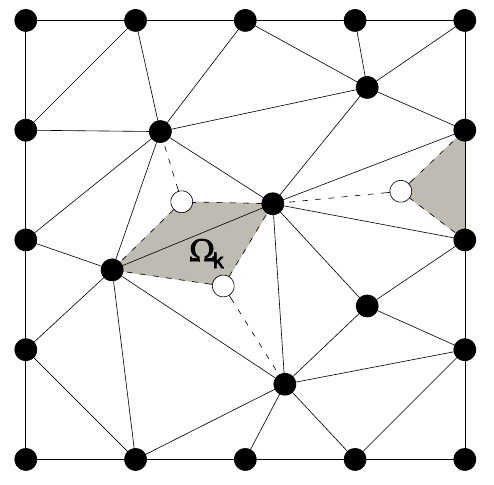Strength and fatigue analysis of periodic perforated materials using the computational homogenization and ES-FEM approaches
Author affiliations
DOI:
https://doi.org/10.15625/0866-7136/16852Keywords:
shakedown analysis, computational homogenization, overall plastic properties, ES-FEMAbstract
This paper presents a computational homogenization shakedown analysis of periodic perforated materials with von Mises matrices. The plastic behaviors of the perforated materials under cyclic macroscopic loads are studied by means of kinematic shakedown theorem and computational homogenization method. The kinematic micro-fields are approximated by the edge-based smoothed finite element method. The resulting large-scale optimization problem is efficiently solved by using conic solver, enabling a large number of points on the macroscopic strength and fatigue surface to be calculated rapidly. The effects of the hole's shape and size on the overall strength and fatigue domains are also investigated.
Downloads
References
R. J. M. Smit, W. A. M. Brekelmans, and H. E. H. Meijer. Prediction of the mechanical behavior of nonlinear heterogeneous systems by multi-level finite element modeling. Computer Methods in Applied Mechanics and Engineering, 155, (1-2), (1998), pp. 181–192.
V. Kouznetsova, W. A. M. Brekelmans, and F. P. T. Baaijens. An approach to micromacro
modeling of heterogeneous materials. Computational Mechanics, 27, (2001), pp. 37–48.
M. G. D. Geers, V. G. Kouznetsova, and W. A. M. Brekelmans. Multi-scale computational homogenization: Trends and challenges. Journal of Computational and Applied Mathematics, 234, (2010), pp. 2175–2182.
G. Maier and V. Carvelli. A kinematic method for shakedown and limit analysis of periodic heterogeneous media. In Inelastic Behaviour of Structures under Variable Repeated Loads, pp. 115–132. Springer, (2002).
V. Carvelli. Shakedown analysis of unidirectional fiber reinforced metal matrix composites. Computational Materials Science, 31, (1-2), (2004), pp. 24–32.
H. X. Li. Kinematic shakedown analysis of anisotropic heterogeneous materials: a homogenization approach. Journal of Applied Mechanics, 79, (2012).
H. X. Li. A microscopic nonlinear programming approach to shakedown analysis of cohesive–frictional composites. Composites Part B: Engineering, 50, (2013), pp. 32–43.
J. A. König. Shakedown of elastic-plastic structures. Elsevier, (2012).
G. R. Liu, T. Nguyen-Thoi, and K. Y. Lam. An edge-based smoothed finite element method (ES-FEM) for static, free and forced vibration analyses of solids. Journal of Sound and Vibration, 320, (2009), pp. 1100–1130.
C. V. Le, H. Nguyen-Xuan, H. Askes, and T. Nguyen-Thoi. Computation of limit load using edge-based smoothed finite element method and second-order cone programming. International Journal of Computational Methods, 10, (2013).
C. V. Le, P. H. Nguyen, H. Askes, and C. D. Pham. A computational homogenization approach for limit analysis of heterogeneous materials. International Journal for Numerical Methods in Engineering, 112, (10), (2017), pp. 1381–1401.
V. Carvelli, G. Maier, and A. Taliercio. Kinematic limit analysis of periodic heterogeneous media. Computer Modeling in Engineering and Sciences, 1, (2), (2000), pp. 19–30.
M. Trillat and J. Pastor. Limit analysis and Gurson’s model. European Journal of Mechanics-A/Solids, 24, (5), (2005), pp. 800–819.
A. L. Gurson. Continuum theory of ductile rupture by void nucleation and growth: Part I—yield criteria and flow rules for porous ductile media. Journal of Engineering Materials and Technology, 99, (1977), pp. 2–15.

Downloads
Published
How to Cite
Issue
Section
License

This work is licensed under a Creative Commons Attribution-ShareAlike 4.0 International License.
Funding data
-
National Foundation for Science and Technology Development
Grant numbers 107.02-2018.31









